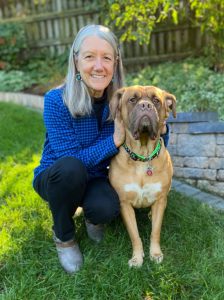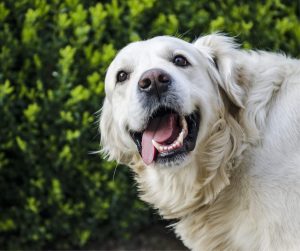
Terry Lackmeyer
Customer Service Representative

The best time to get a dog used to having its teeth brushed is when it is a puppy. Puppies are quite malleable and with patience and treats, they will learn to have their teeth brushed. Start by gently handling their face and mouth. Use lots of praise and treats. Gently push their lips back exposing their teeth. Run your finger over their teeth. Add a small dollop of peanut butter to your finger, then rub this on the teeth and in the mouth. Make a game of it, make it fun. It may take several days or even longer for them to get used to this activity.
Once your puppy is comfortable with you manipulating their mouth and rubbing your finger over their teeth, try wrapping gauze around your finger and gently rubbing that over their teeth. Again, you can place a bit of peanut butter on the gauze and rub that over the teeth. Continue making this fun, giving lots of praise and treats. Once the dog is comfortable with peanut butter on the gauze, try switching to an enzymatic toothpaste in a flavor dog’s like, such as beef or chicken. These toothpastes are sold in local pet stores and veterinarian clinics.
Finally, the last step is using a toothbrush or finger brush to clean your dog’s teeth. A dog toothbrush looks very much like a human one, while a finger brush is a rubber form that fits over your finger and has a brush attached to it. You can use a human toothbrush; just be sure it has soft bristles and select the child’s size. Place the enzymatic toothpaste on the brush and gently brush your dog’s teeth, working at a 45-degree angle. You will find that your dog licks the toothpaste while brushing, which is fine as it is safe for your dog to swallow. Never use human toothpaste to brush your dog’s teeth as it contains products that can harm your dog if swallowed.
If your dog is a bit older and you want to start brushing their teeth, check with your veterinarian prior to starting. Your dog may need to have their teeth professionally cleaned to remove any tartar that has built up on their teeth. Brushing will not remove that hard calcification and the teeth will need to be scraped to get that off. If your dog had their teeth professionally cleaned by your vet, wait a week or so before trying to brush their teeth, possibly longer if they had any teeth extractions. Their mouth may be sensitive from the cleaning or tooth extraction, and you do not want to work on their mouth if it bothers them. Follow the same procedures previously described for acclimating a puppy to toothbrushing, but use caution. Not all dogs tolerate having their mouth worked on and tooth brushing may feel very foreign to them. Only you know what your dog is able to tolerate. Do not risk getting bitten if your dog will not tolerate toothbrushing.
If your dog refuses toothbrushing, there are numerous products on the market that can help to clean their teeth and freshen their breath. Some dogs don’t mind the gauze being wiped over their teeth so for them there are dental wipes. These are good to use in place of gauze during the training phase.
There are different dental rinses that can be added to your dog’s water. These rinses contain enzymes that help battle bacteria and plaque buildup in your dog’s mouth. Do not use human mouthwash as it is not formulated for pets, nor should it be swallowed.
Dental chews, toys, dental food, and food additives can help with your dog’s dental hygiene. Dental chews taste great to dogs and are designed to scrape plaque from the teeth, particularly the back molars. The same goes for dental toys. Dental food comes in special shapes and sizes and is formulated to help scrape plaque from the teeth. Food additives are powders sprinkled on your pet’s food that contain enzymes to help combat plaque and bacteria.
While all of these alternative options will help to combat plaque and tartar, nothing works as well as regular brushing. If your dog will not tolerate brushing, it is important to schedule a dental scaling with your vet. Depending on your dog, this may need to be done yearly, but could go to every two to three years. Your vet is the best person to ask for advice regarding your dog’s dental care and they will be familiar with all the latest products available to help with that care.
Little dogs, such as Yorkies, Maltese, and other toy breeds are particularly prone to tooth problems due to the structure of their mouths and faces. The teeth are more crowded together in their small jawline and they have less chewing activity than larger dogs, meaning they chew on bones and toys far less than larger dogs do. Additionally, smaller dogs tend to eat more wet food in their diet than hard kibble which makes them more prone to plaque and tartar buildup. Keeping in mind that small dogs can easily live into their mid to late teens, making them more prone to tooth loss as they age, it is particularly important that these dogs have good dental hygiene.
Just as with humans, it is important to brush your dog’s teeth daily. The plaque that gets on your dog’s teeth is easy to remove when soft, but once it calcifies it only can be removed with scraping which needs to be done by your veterinarian. If daily brushing is not possible, try at least three times per week. Following this routine will help keep your pet’s breath smelling better and will definitely help them to live a happier, healthier life.
